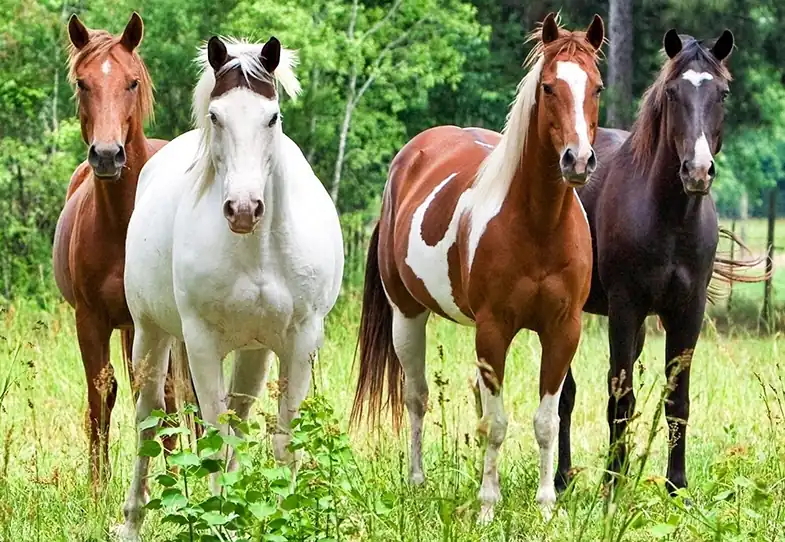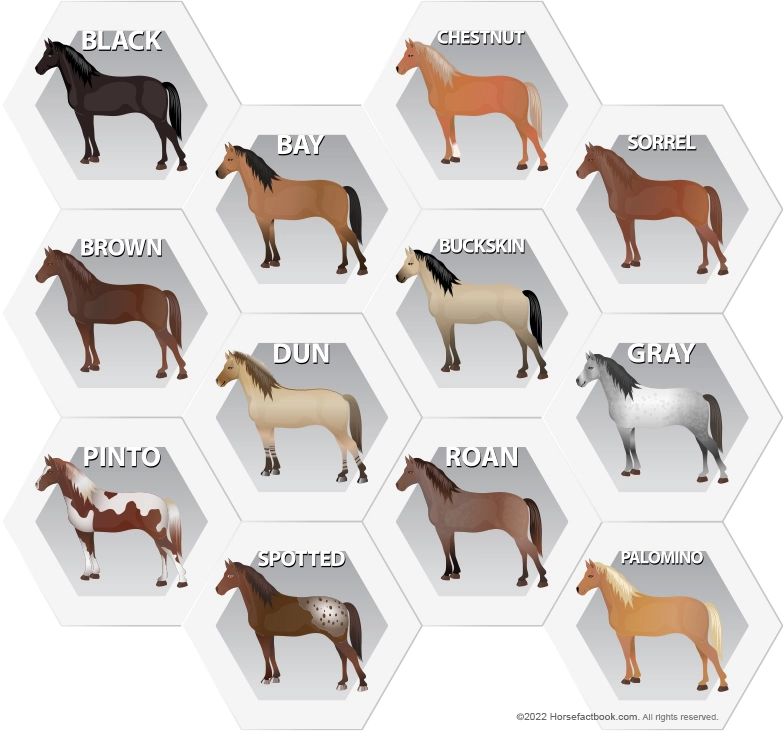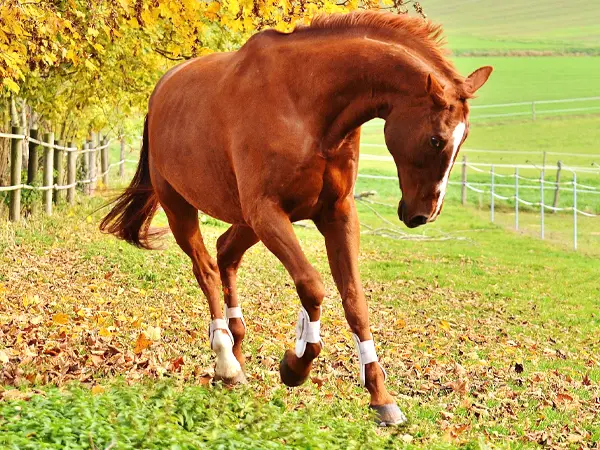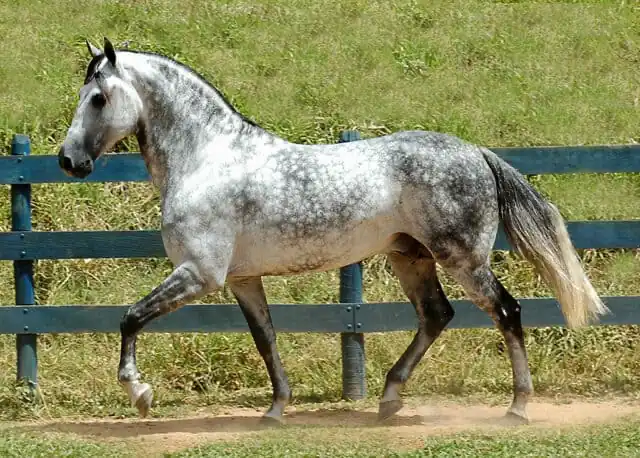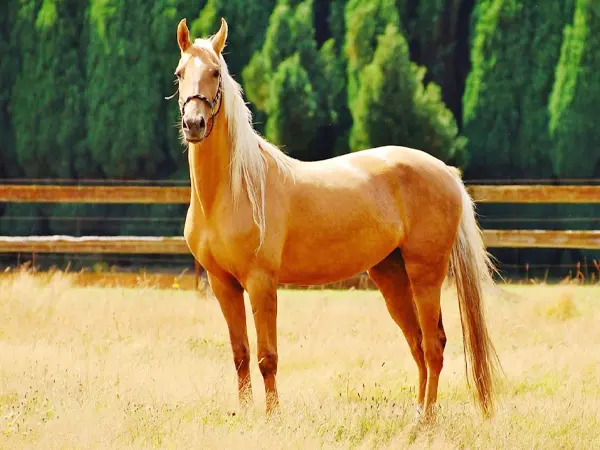Have you ever wondered what makes a horse with white hair gray, why a horse with an even mix of black and white hair is called a blue roan, or even what the difference between a dun or a buckskin is? If you answered yes to any of those, or just want to know more about horse coat colors then you’ve come to the right place.
What are the most common horse colors? Horses can be found in a wide variety of different colors but the most common colors are black, bay, chestnut, sorrel, brown, dun, buckskin, gray, pinto (or Paint), spotted, roan, and palomino. One of the rarest coat colors though is white.
How many horse colors are there?
Given the fact that there are only four basic horse colors (black, bay, brown, and sorrel or chestnut), along with the non-pigmented color of gray you might be surprised to know that there is an almost endless variety of horse colors. The reason for this is the presence of different genes in a variety of different combinations.
These genes, sometimes referred to as dilution genes, can turn a black horse into a smoky cream-colored one or a bay horse into an almost orange-looking one. That said though, there are 12 common horse colors and another 12 rarer colors. In this article, I’ll cover the 12 most common colors, but in this other article on this site, I cover the 12 rare horse colors in detail.
Base colors
While there’s a whole spectrum of different colors you might be surprised to know that every single one of them is derived from just one of two different colors, black or red, along with white which is just the lack of pigment rather than an actual color.
- Black – A horse with a black base coat will have black points (the ears, mane, tail, and legs). Colors with a black base are black, bay, buckskin, grullo, perlino as well as blue and bay roan.
- Red – Unlike the black base coat, horses with a red base won’t have any black points, regardless of how dark their mane and tail may appear. Colors with a red base are chestnut, cremello, and pearl.
- White – Any art teacher will tell you that white isn’t actually a color and this is kind of true when it comes to horses too. Okay so white is a hue instead of a color but when it comes to horses it’s actually the lack of pigment (the natural coloring of tissue) that makes the hair white.
Basic horse colors
Some people consider gray and white to be basic coat colors but in fact, there are only really three basic horse colors from a genetics standpoin, black, bay, and chestnut. These three colors are produced by a combination of just two genes, the extension gene (E) which is responsible for deciding whether the body color is black or red, and agouti (A) which determines the base color itself.
- Black – The horse has at least one dominant copy of the extension gene (and either no agouti gene or recessive copies) and is completely black.
- Bay – Like black horses, bay horses have at least one dominant extension gene and one or two dominant agouti genes. These horses will have a brown body and black points.
- Chestnut– Chestnu horses only have reside extension genes and at least one dominant agouti gene. Like bay horses they have a brown body but they also have brown (or red) points.
- Gray – Despite the lack of color all gray horses have at least one dominant extension gene although they don’t have any pigment. This dark base color means they’re classed as gray instead of white.
- White – As you can probably guess white is the opposite of gray in that the horse has a red base coat instead of a black one. This means their skin is pink and therefore the hair is white.
The 12 most common horse coat colors
While horses can be found in a variety of colors there are only 12 common colors.
Black Coat Color on Horses
Black horses are completely black from head to toe although they can have a small amount of white on their faces, such as a star or snip. They all have at least one dominant extension gene and either no agouti genes or only recessive ones.
Most black foals are born dark gray or dun (with a black mane, tail, and dorsal stripe) and start to turn black as they begin to shed their coats. Some black foals, however, are born pure black but this isn’t very common.
Some people say that a true black horse, like a true white horse, is extremely rare but this isn’t quite true. They are, however, uncommon. This is because dark brown horses are often mistaken for black horses.
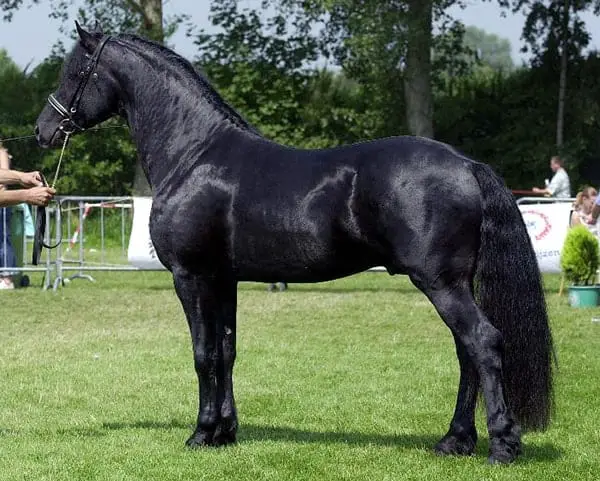
True black horses
There are two types of true black horse, fading (or faded) black and non-fading black which is often referred to as blue-black. Genetically there’s no difference between the two but fading black horses can fade to a brown color if they spend too much time in the sun. Another distinguishing feature of a true black horse is the presence of black points. Dark brown or bay horses may appear black but the presence of lighter hairs around their eyes, muzzles, and flanks indicates they are not black. On a truly black horse these hairs will also be black.
Breeds with black coats
Being one of the basic horse colors many breeds have black horses but there are a handful that are almost exclusively black, breeds such as the Mérens, Murgese, or the Friesian. Some breeds such as the Dales Pony and Fell Pony (both from Britain) or the Percheron are predominantly but not exclusively black.
Bay Coat Color on Horses
A corruption of the Latin word badius (meaning chestnut or brown), bay horses can be as light as a reddy-brown or as dark as chocolate brown but because their base color is black they always have black points. While the body color of a bay can be any shade of brown there are three main ones:
- Dark Bay – Sometimes called black bay, these are horses with a very dark brown body color.
- Mahogany Bay – These horses have a dark reddy-brown body color.
- Blood Bay – Also known as red bay, these horses have a bright reddy chestnut body color.
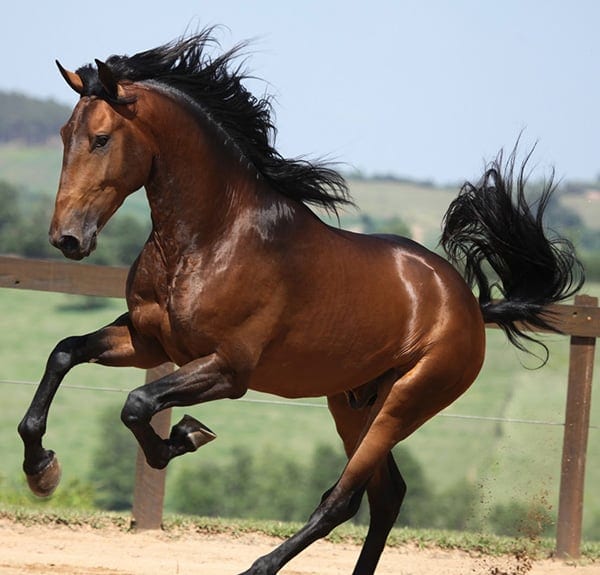
Breeds with bay coats
Bay can be found in almost all horse breeds around the world but some breeds are predominately known for their bay coats, these include the Clydesdale, Cleveland Bay, Exmoor Pony, Morgan, and the Tennessee Walker which I’ve written about in more detail in this article.
Chestnut Coat Color on Horses
Taking its name from the chestnut tree, the word chestnut (or castaneous as is occasionally used) is used to describe a horse that has a reddy brown body color and either a similar or lighter colored mane and tail.
As you might expect the base color for all chestnut horses is red and, such, they don’t have any black markings. Like the bay coat there are a lot of different shades but there are four main ones:
- Liver Chestnut – As you can probably guess the color is a dark reddy chestnut which is sometimes referred to as a brown chestnut or red chestnut.
- Flaxen Chestnut – The mane and tail of a flaxen chestnut horse will be a lighten flaxen color while the body will be any shade of chestnut. While it may look similar genetically it’s very different from the palomino.
- Light Chestnut – This is the lightest of all chestnut shades and is used to describe a chestnut horse who’s body and mane and tail are a pale, almost yellowy shade of chestnut.
- Sorrel – Sorrel is by far the most common shade of chestnut and is a deep reddy-tan color that’s said to be the same color as a newly minted penny.
Breeds with chestnut coats
Like bay, the chestnut color can be found in the vast majority of horse breeds although some are known for their chestnut coats. These include breeds such as the Haflinger, Avelignese, and the Suffolk Punch. As an interesting footnote the Suffolk Punch breed registry spells the color slightly differently, they drop the first ‘t’ and instead spell it chesnut.
Sorrel Coat Color on Horses
It’s not known where the name sorrel comes from but it’s believed it’s named after the flowers of the sorrel plant which are a deep coppery red color.
While sorrel is technically just a shade of chestnut I’ve included it separately because, in the Western riding world at least, it’s a color in its own right.
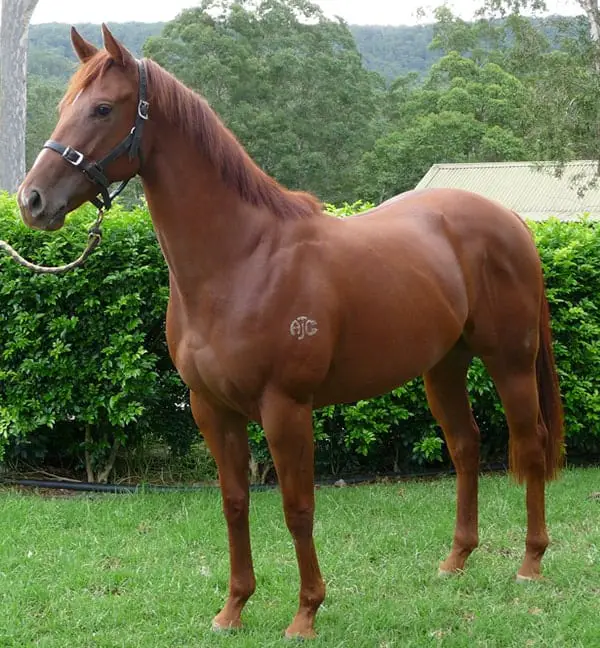
Breeds with sorrel coats
Being a shade of chestnut the color can be found in a range of different breeds but it’s by far the most common color for Quarter Horses and Mountain Pleasure Horses.
Brown Coat Color on Horses
Some people wrongly refer to brown horses as bays but the main difference is that brown horses don’t have black points, although if their body color is very dark then so will their mane and tail be. Brown horses will also have light brown or tan colored hairs around their eyes, muzzles, and flanks.
While brown horses must obviously be brown in color they can be any shade of it, ranging from a very dark, almost black looking, brown to a very looking caramel brown. During the winter months, many brown horses appear to have a darker color coat, in part due to the thickness of it but also the reduction in sunlight.
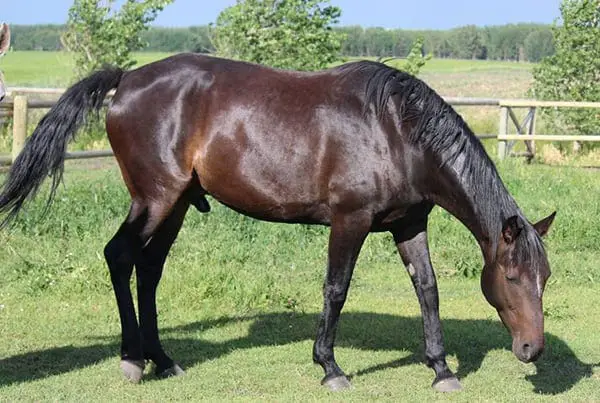
Breeds with brown coats
Being a basic color, brown can be found in most horse breeds but it’s more common in some breeds. It’s one of the main colors found in most warmblood breeds, but other breeds include the Ukrainian Riding Horse, Don, and Peruvian Paso.
Dun Coat Color on Horses
Dun is one of those colors whose existence is due to the presence of a dilution gene although, unlike a lot of other dilution genes, the dun gene is also responsible for the horse’s markings. Known as primitive markings these include a dorsal stripe that runs the length of the horse’s back and zebra markings on the lower legs and are common in wild horses but aren’t always prevalent in domesticated horses.
Horses with either a red or black base color can be affected by the dun gene although the results will vary depending on the base color.
- Grullo – Also known as blue dun, this is caused by a black horse having the dun modifying gene. The gene will cause the black coat to lighten to a silvery, smokey, or mousey color although the primitive markings will still show through.
- Red Dun – The red color of the red dun is caused by the presence of the dun gene in a chestnut or sorrel horse, the coat is lightened to either a pale yellow or a tan which makes the primitive markings much more obvious.
- Classic Dun – Sometimes referred to as a bay dun or zebra dun, these horses have a golden coat with black markings. As you can probably guess, the color is caused by the presence of the gene on a bay horse.
- Yellow Dun – Also called a buckskin dun this occurs when any dun horse also carries the cream gene. The combination of both of these genes will produce a light golden coat with black points and primitive markings.
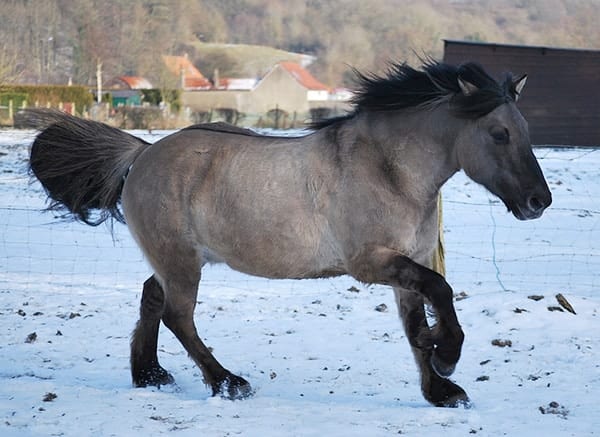
Breeds with dun coats
Considered a primitive color, dun is found in many ancient breeds such as the Exmoor Pony, Norwegian Fjord, and Highland Pony. It’s also found in a number of wild and feral breeds such as the Przewalski and Konik.
Buckskin Coat Color on Horses
Far more common (and popular) in the States, buckskin horses are bay horses that have a single copy (or dose) of the cream (or creme) dilution gene. This gene lightens the brown body color of the horse, changing it from brown to a faded tan color. While a light tan is the most common shade of buckskin, horses can range from a light creamy yellow color to a deep golden shade of brown.
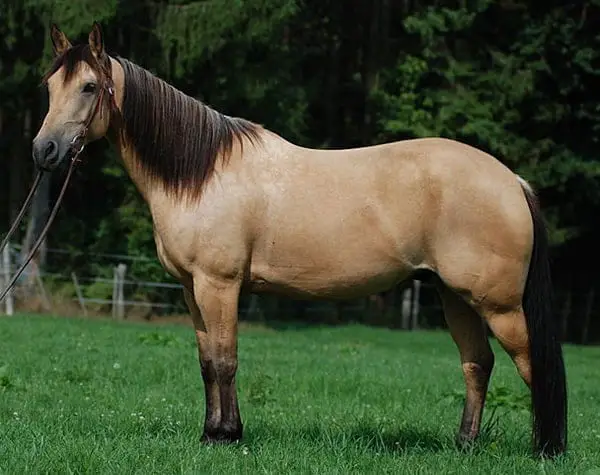
Breeds with buckskin coats
Some breeds societies, such as the Shire horse and Arabian, don’t allow buckskin colored horses to be registered but they can still be found in a large number of other breeds. Such as the Quarter Horse, Peruvian Paso, and the Mustang.
Gray Coat Color on Horses
All gray horses, regardless of the color they’re born, will have black skin which is why they’re classed as gray rather than white. While some horses are born gray most aren’t but because they’re carrying the graying gene (or gray modifier) they begin to ‘gray out’ and either become completely solid gray or any one of a range of different variations.
In order to produce a gray horse, one or both parents will need to be gray, although there’s only a 50% chance they’ll pass the gene on, even if both horses are gray.
- Steeldust – A dark gray that is an even mix of white and dark hairs, giving a salt and pepper appearance.
- Dappled Gray – A gray coat that has white spots (known as dapples) over it.
- Rose Gray – Horses that are born with a bay or chestnut base coat will gray out with a red or pink tint.
- Flea-bitten – The horse looks completely gray except for the appearance of specks or flecks of color.
Breeds with gray coats
The graying gene is a dominant gene which means that it will eventually cover the original color, this is why some registries (especially those that have an emphasis on a certain color or pattern) won’t allow horses with this gene to be registered in the main registry.
That said though there many breeds that are predominantly gray, breeds such as the Lusitano, Lipizzaner, and Camargue.
Pinto (or Paint) Coat Color on Horses
Sometimes referred to as Paint, the pinto pattern can be any base color with, often large, patches of white over the whole body. Some breeds such as the Paint Horse describe the coat by the pattern while others (albeit mainly in the UK and Europe) describe it by the combination of colors.
- Tobiano – Sometimes called toby, this is caused by the tobiano gene and results in the horse having large white areas over a darker base color. Typically one or both flanks will have color with white patches while the mane and tail can be both colors.
- Overo – Overo is Spanish for ‘like an egg’ which gives you some idea of the irregularity of the pattern. Like tobiano, the horse has a dark base color but this time the white patches don’t cover the back and are mainly, although not solely, confined to the legs and head with the horse having blue eyes.
- Tovero – This pattern is a mix of both the tobiano and overo pattern and normally includes characteristics such as blue eyes.
- Sabino – Although it does technically refer to any pattern caused by the Sabino 1 gene, its also used to describe a horse that has the same pattern (even if it doesn’t have the gene). Typically sabino horses will be dark-colored with white patches or spotted over their belly, chin and hocks.
- Piebald – Most commonly used in the UK and with the Gypsy Horse breed, piebald is used to describe any horse with black and white patches of color.
- Skewbald – This pattern refers to a coat that has patches of white and any other color except black, like the piebald its mainly used in the UK and to describe the Gypsy Horse.
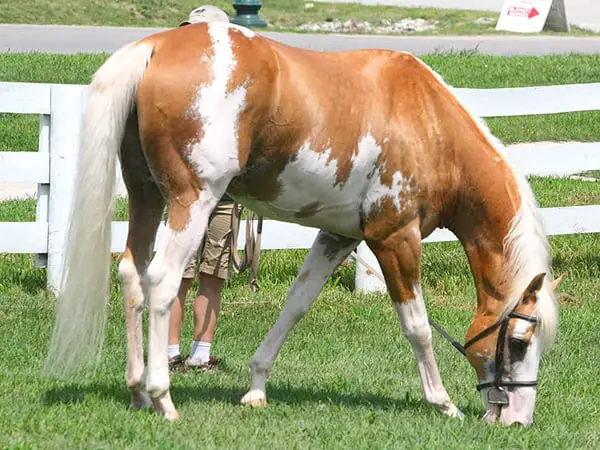
Breeds with pinto coats
Not all breed registries will accept colored horses but some breeds such as the Shetland Pony or the Mustang allow them. Then there are breeds such as the Paint Horse and Gypsy Vanner that are known for the pinto coloring.
Spotted Coat Colors on Horses
There are six different spotted coat patterns that are all caused by the leopard complex gene (also known as the LP gene, or LP complex). As well as the spotted coat this gene is also responsible for other characteristics such as a white sclera (the hard area around the outside of the eye that is normally dark-colored in other horses), pink and black mottled skin around the eyes, muzzle, and genitals along with striped hooves.
Not all horses with the gene will display spots but most will show the other characteristics, even on solid-colored horses.
- Leopard – Also known as full leopard, horses with this pattern will have a white coat with either black or brown (red) spots over the entire body including the head and legs. Just as the saying goes leopard spotted horses will never change their spots.
- Near Leopard – Unlike the leopard pattern, horses with this coloration will have a darker head and legs and occasionally part of their body will be darker too. As the horse ages, the darker color will fade and the horse will appear to have a full leopard pattern.
- FewSpot Leopard – FewSpot leopard horses will have a white coat with only a few ‘splashes’ of color around their head, neck, and flank.
- Blanket – There are a number of different blanket patterns but they generally involve a horse having a dark body (including the head and legs) with a white patch or blanket, over their rump.
- Spotted Blanket – The white rump, which can cover most of the horse’s body as well as their hindquarters, will be covered in spots that are the same color as the rest of the horse.
- White – Like the spotted blanket, the white area can cover most of the horse, but in this case, it’ll have very few spots if any at all.
- Frosted – Sometimes called frosted hip, this pattern is different from other blanket patterns because the horse doesn’t have a blanket at all, instead, they have a few white spots over their rump which gives the impression of frosting.
- Snowflake – Some people refer to the snowflake pattern as an inverted leopard but this isn’t quite the case. Yes, the horse has a dark-colored body with white spots, but the spots are much smaller and look a little like snowflakes. A lot of snowflake horses are born with solid coats that gray out with age, often resulting in a roan colored horse.
- Marble – Horses with this pattern often look like roans but the white hairs will form ‘vanish marks’ that give the appearance of spots.
Breeds with spotted coats
The Appaloosa is by far the most well known ‘spotted’ horse breed (which is why the pattern is sometimes referred to as Appaloosa coloring) although breeds such as the Pony of the Americas, British Spotted Pony, Noriker, and Colorado Ranger all have the spotted pattern as their predominant color.
Roan Coat Color on Horses
While the name roan refers to the roan gene it’s also a general term describing a horse that has an even mix of white and other colored hairs over its entire body (the head, mane, tail, and legs are often darker in color too). Despite the presence of a large number of gray hairs, roans don’t gray out with age.
- Red Roan – Also called strawberry roan, the base color of this roan is chestnut, and while the body will be roan the mane and tail will be the same shade of red as the body if it didn’t have white hairs.
- Bay Roan – The base color of bay roans is bay which is why a roan horse will often have a black mane and tail.
- Blue Roan – While the blue roan will look similar to grullo it’ll have a darker head and won’t lighten with age, as with all roans they will also have an even mix of white hair while the grullo will have lighter hairs instead of white.
- Rabicano – Sometimes called white ticking, this pattern isn’t a true roan because the lighter color (which is normally only present on the belly, flank, legs, tail, and head) is caused by the rabicano modifier gene rather than by white hairs.
Breeds with roan coats
Some breeds, such as the Thoroughbred and Arabian, don’t allow roan horses to be registered but the color is very popular with Quarter Horses, Paso Finos, and Missouri Fox Trotters.
Palomino Coat Color on Horses
Taking its name from the golden palomino grape, this color is the result of the one copy of the cream gene being present in a chestnut or sorrel horse. The color range is said to be anything from three shades lighter or darker to that of a newly minted gold coin. The body color can be as light as a cremello but can also be a deep shade of chocolate although the mane and tail will always be flaxen or white.
Breeds with palomino coats
In America, there are two registries for palomino horses but that doesn’t mean it’s a breed, which is why the palomino color can be found in many breeds around the world as such the Haflinger and the Quarter Horse. It’s worth mentioning that around half of all palominos in the world are Quarter Horses.
TIP: If you want to enhance the color of your horse’s coat then why not use Gallop’s Colour Enhancing shampoo? With a range of different colors, it’s specially formatted to bring out your horse’s natural color.
I hope you found this article helpful. If you did I’d be grateful if you could share it please as it would really help me.
Recommended products
Over the years I have tried hundreds of different horsey products, from various blankets and halters to different treats. Some I’ve loved, others I’ve hated but I thought I’d share with you my top all-time favorite products, the ones I never leave the yard without. I’ve included links to the products (which are in no particular order) that I really think are great.
- Horse Knots by Reference Ready – If you’re like me and enjoy pocket reference guides then you’ll love this knot tying guide. These handy cards can easily fit in your pocket or attach to the saddle for quick reference. They’re waterproof, durable and are color coded to make them easy to follow.
- Mane ’n Tail Detangler – Even if you never show your horse you’ll need to detangle his tail from time to time (and possibly his mane too) which is always a challenging chore! I’ve found that if I run a little bit of detangler through my horse’s tails every few days it stops them from getting matted up and makes combing them easy, even if they’re coated in mud. I don’t know if I should admit to this or not but it also works wonders on my hair.
- TAKEKIT Pro clippers – Over the years I’ve tried a lot of different clippers and while some were obviously better than others I found these to be by far the best. They are heavier than a lot of other clippers but for me, that’s a good thing, it makes them feel more sturdy and hardwearing. On top of that they have a range of speeds so are just as good for clipping your horse’s back as they are his face. I also like the fact that they come in a handy carry case but that’s not for everybody. The company that makes them is super good and incredibly helpful too, a real bonus these days. The only thing I wasn’t keen on was the fact that it doesn’t come with any oil, but that’s not a major problem as it’s not difficult to buy lubricant.
- Shire’s ball feeder – There are so many boredom buster toys out there but I like to use these every day, regardless of whether or not my horses are bored. I find that it helps to encourage my horses to problem solve by rewarding them with treats (or pieces of fruit) but it also mimics their natural grazing behavior which helps to keep them calm and de-stressed.
- Horse safe mirror – This is a strange one that many people are surprised about but I like to put horse safe mirrors in the trailers as well as in the quarantine stalls. It helps to prevent the feeling of isolation by giving the impression of other horses being around. Being herd animals horses can get extremely stressed when they feel that they’re on their own but with these stick-on mirrors, they believe that at least one other horse is with them.
- Rectal thermometer – I know this isn’t glamourous at all but it’s vital for your horse’s well-being to be able to check their temperature and a rectal thermometer is the easiest way of doing this which is why I’ve added it to the list.
Shopping lists
I’ve also put together a few shopping lists of essential items that I’ve found helpful over the years. I’ve broken the lists down into different categories rather than put everything in one massive list 😉

